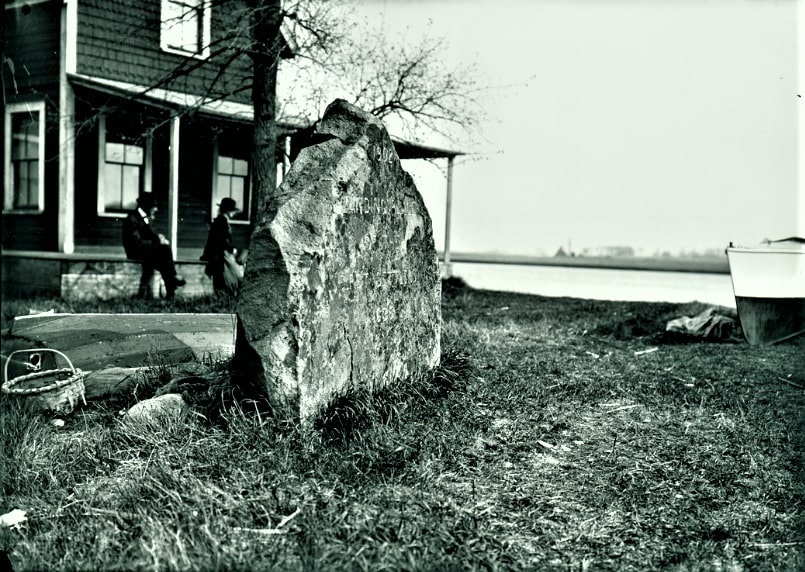Introduction: In this article, Melissa Davenport Berry continues her story showing how paternity cases affected life in the 17th century Massachusetts Bay Colony – and, in particular, describes the Coker family line. Melissa is a genealogist who has a blog, AnceStory Archives, and a Facebook group, New England Family Genealogy and History.
In recent articles, I’ve been covering the early paternity cases of 17th century New England (see links at the end of this article). Next on my list is Robert Coker (1606-1680) of Newbury, Massachusetts, cited in the “Records and Files of the Quarterly Courts of Essex County V. 1” (RFQCEC) available online through the University of Virginia.

Coker appeared in court twice for his illicit lovemaking and was punished with the strap, but his maiden paramour was excused. Here is the scoop.
Court records from December 1641 state: “Robert Coaker of Newbury and Miriam [Moulton] Kinge of Hampton, New Hampshire, were presented for fornication.” (P. 39)
According to historian Bethany Groff in A Brief History of Old Newbury: From Settlement to Separation, Robert is purported to be the first man tried in the Essex County Quarterly Court for the crime of fornication.
Robert and Miriam were both married by 1641: Robert to Catherine (surname unknown) and Miriam to Thomas King. A daughter named Rachel was born to Miriam in 1639/40 and a son named Joseph was born to Robert in 1640.
However, in December 1642 another court record cites: “Robt. Cocker betrothed himself too securely to one maiden, and then contracted with another woman. To be severely whipped, and to pay to Thomas Kinge, who subsequently married the first maiden, five pounds.”
Why was Robert ordered to pay damages to King? It is not stated. In Daughters of Eve: Pregnant Brides and Unwed Mothers in Seventeenth Century Essex County, Massachusetts, author Elise L. Hembleton wrote: “Whether the money was for compensation for the loss of Moulton’s virginity, King’s honor, or child support, is not spelled out, but to those involved it must have been so apparent that no explanation was needed.” (P. 30)
Groff believes that the 5-pound damages was paid to King for Miriam’s loss of virginity (P. 34-35). Miriam (née Moulton) married Thomas King in December 1641, the same month as her court appearance with Coker. Groff asserts that Coker became engaged to Miriam, broke off the engagement and married Catherine, and was then accused by Miriam or her husband Thomas of fornication: “Because the two had been engaged at the time of the illicit acts, the court released Moulton [the maiden] with permission, but sentenced Coker to be severely whipped.”
Additionally, the “Great Migration V. 2” noted it is possible – but not proved – that Miriam’s first child (Rachel) was with Coker. Rachel married Christian Dolloff of Exeter, New Hampshire. (P. 143, Anderson, Robert Charles)
The other babe in this drama was Joseph Coker, born on 6 October 1640. He was the son of Catherine (the other maiden), who married Robert. Some believe Catherine was a Moody, but there is no concrete evidence – only a few wills that suggest a connection.

This Newburyport Herald article shared research on Robert Coker cited from the Genealogical Register. He is listed as one of the 50 passengers who came over on the ship Mary & John of London in 1633-34 (Robert Sayres, Master), and one of the 20 who settled in Newbury.
I will soon cover some notable descendants of Robert Coker, which include Robert Adams Coker, mathematician, as well as the family lines who became Quakers. Stay tuned for more on the Coker clan.
Children born to Robert and Catherine Coker:
- Sarah (married James Smith, son of Thomas Smith)
- Hannah (married Daniel Lunt, son of Henry and Ann Lunt)
- Benjamin, a ship carpenter (married Martha Perley, daughter of Allen Perley and Susanna Bokesen?)
- Joseph (married Sarah Hathorne: daughter of Judge William Hathorne, the noted Quaker persecutor; and sister to Judge John Hathorne, who presided over the witch trials in Salem in 1692)
Note: Just as an online collection of newspapers, such as GenealogyBank’s Historical Newspaper Archives, help tell the stories of the Coker family line, they can tell you stories about your ancestors that can’t be found anywhere else. Come look today and see what you can discover!
Related Articles:

Melissa, thank you for your terrific articles. I’m a 10th GGdaughter of Robert Coker/Catherine. You have done exceptional research and I want to thank you for sharing it.
Thank you Erin, I so appreciate it! GenealogyBank is such a wonderful source for research, and complements as well as adds color to the old court cases of Essex County!